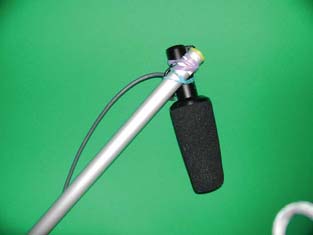Hack 53. Make Your Own Boom
| < Day Day Up > |
|
To capture better audio than that offered by your camera, you'll need a long pole and a decent microphone. A boom, sometimes called a boompole or fishpole, is essentially a long pole used to hold and maneuver a microphone, which is at one end of the pole. Using a boom allows you to get the microphone closer to your subject, while still keeping it out of the frame's composition. Although you can purchase professional-quality booms online (search for boompole), it is easy to build your own. 5.4.1. Finding a PoleFirst, and foremost, a boom is a pole, so that's what you'll need. The length of the pole will determine how far away from the subject you can be, while still recording audio. You can use something as simple as a broomstick or as elaborate as a telescoping aluminum pole. The most flexible option is to locate a telescoping pole, as it will allow you to adjust the length of your boom to fit whatever situation you might find yourself. 5.4.2. Purchasing a MicrophoneAudio is an important aspect of digital video, yet it is often an afterthought. Many microphones are on the market, and each one has its pros and cons. For use with a boom, you should purchase a shotgun microphone, which looks like a long, thin cylinder, as shown in Figure 5-2. I recommend evaluating the microphones available from Audio-Technica (http://www.audio-technica.com/) and Sennheiser (http://www.sennheiserusa.com/), among any others you might come across. Figure 5-2. A shotgun microphone
Unless you already have a microphone, purchasing a separate microphone is the most important aspect of creating your own boom. With the dollars you save by building your own boom, you can put your money toward purchasing a better microphone. After all, if you audience can't hear what someone is saying on camera, you might as well make a silent movie. 5.4.3. Measuring for CableThe next piece to the boom puzzle is to determine the type of connection that is available on your camera and what type is required by your microphone. Most professional-quality cameras have XLR connectors, while most consumer-quality cameras have either RCA, 1/4", or a mini-jack for connecting an external audio source. Figure 5-3 shows the different connection types available: XLR, RCA, 1/4", and mini. Figure 5-3. XLR, RCA, 1/4", and mini-jack connectors You will need to purchase an audio cable that is longer than the length of your boom, as well as having connectors that will fit into your camera. Ideally, your audio cable will be much longer than your pole at least six feet longer because you will need to run the cable from the top of the pole (where the microphone will be) to the bottom of the pole, and then off to wherever the camera may be. For example, if you have an eight-foot pole, you will want about 14 feet of audio cabling. So, when purchasing your audio cable, remember that it is better to have too much cable than not enough. 5.4.4. Putting It All TogetherAfter gathering all of the necessary items, you need to put them all to use. If you have a telescoping pole, you should place the microphone on the smaller end of the pole. How you attach your microphone to your pole depends on whether your pole is wood or metal, as well as the design of your microphone. When attaching your microphone, you should keep in mind that the microphone is designed to pick up sound. Depending on how you attach your camera, it might also pick up the sound of the boom operator's hands moving against the pole. Therefore, you should create a solid mount point where the microphone won't rub or bang against anything, as well as separate it from the pole. After all, you're trying to create a system for recording better audio than without the boom. Figure 5-4 shows a boom microphone. Once you've attached your microphone, you need to attach the cable to the microphone and run it down the length of the pole. To keep the cable out of your way, you can use either zip-ties or Velcro to hold the cable against the pole. If you don't have a foam cover for your microphone, or if you are interested in cutting potential wind noise, you will probably want a windsock [Hack #52]. Building your own boom will help you to record better audio, and better audio will lead to better video and a better experience for your viewers. Figure 5-4. Mic on a stick |
| < Day Day Up > |
EAN: 2147483647
Pages: 158
